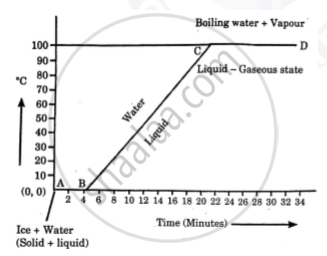Advertisements
Advertisements
प्रश्न
Define boiling point of a liquid.
उत्तर
The constant temperature at which liquid converts into gas is called its boiling point.
APPEARS IN
संबंधित प्रश्न
State two factors upon which the rate of emission of thermions depends.
What is the energy absorbed during the phase change called?
What do you understand by the term latent heat?
Which has more heat: 1 g ice at 0℃ or 1g water 0℃? Give reason.
Calculate the total amount of heat energy required to convert 100 g of ice at −10℃ completely into water at 100℃. Specific heat capacity of ice = 2.1 J g-1 K-1, specific heat capacity of water = 4.2 J g-1K-1, specific latent heat of ice = 336 J g-1.
When a liquid is getting converted into solid, the latent heat is ………………………………
Explain the following temperature Vs. time graph:

Define the following terms:
(i) Specific latent heat,
(ii) Specific latent heat of fusion.
Why does weather become pleasant when it starts freezing in cold countries?
Why water get cooled in a ‘Surahi’ in hot season?
Why does evaporation causes cooling and why is water used in hot water bottles?
Explain the meaning of greenhouse effect.
State two advantages of the high specific latent heat capacity of steam, which is about 226 × 104 J/kg?
What observation you will record and how will you determine the specific latent heat of fusion of ice?
Calculate the total amount of heat required to convert 100g ice at 0°C to steam at 100°C.
(Specific latent heat of fusion of ice = 336 J/g, specific latent heat of vaporization of steam = 2260 J/g, specific heat capacity of water = 4.2 J/g°C).
1 kg of dry air at a temperature of 40 °C can hold a maximum of 49 g of water vapour.
For the same mass of ice and ice-cold water, why does ice produce more cooling than ice-cold water?
Specific latent heat L = ______.
Give some practical applications of specific latent heat of ice.
